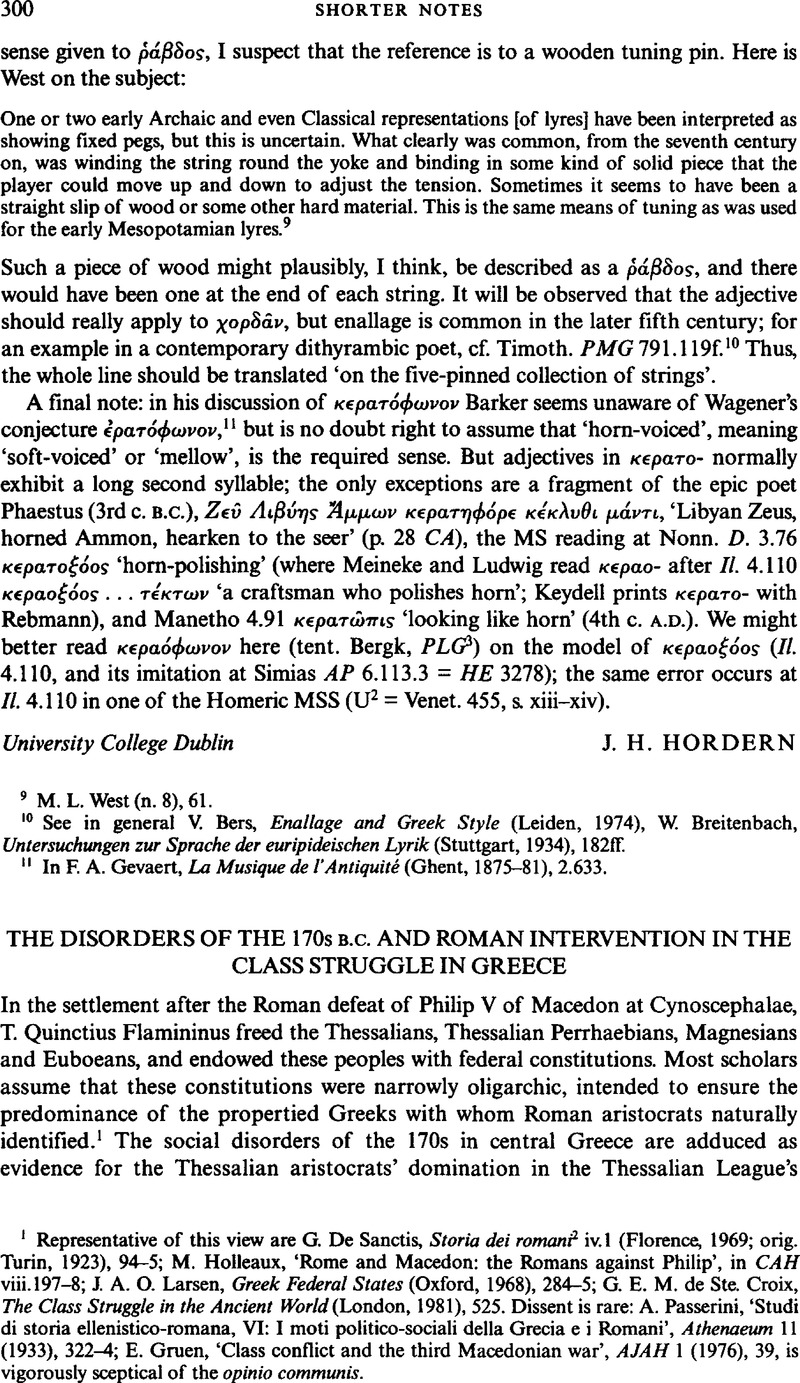Article contents
The disorders of the 170s b.c. and Roman intervention in the class struggle in Greece
Published online by Cambridge University Press: 11 February 2009
Abstract

- Type
- Shorter Notes
- Information
- Copyright
- Copyright © The Classical Association 2000
References
1 Representative of this view are De Sanctis, G., Storia dei romani iv.l (Florence, 1969; orig. Turin, 1923), 94–5; M. Holleaux, ‘Rome and Macedon: the Romans against Philip', in CAH viii. 197–8;Google ScholarLarsen, J. A. O., Greek Federal States (Oxford, 1968), 284–5Google Scholar; Croix, G. E. M. De Ste., The Class Struggle in the Ancient World (London, 1981), 525.Google Scholar Dissent is rare: Passerini, A., ‘Studi di storia ellenistico-romana, VI: I moti politico-sociali della Grecia e i Romani’, Athenaeum 11 (1933), 322–4Google Scholar; Gruen, E., ‘Class conflict and the third Macedonian war’, AJAH 1 (1976), 39Google Scholar, is vigorously sceptical of the opinio communis.
2 Larsen (n. 1), 285; cf. De Sanctis (n. 1), 108–9,263; Holleaux (n. 1), 198. For bibliography on the disorders in Thessaly, see Mendels, D., ‘Perseus and the socio-economic question in Greece (179–172/1 B. C). A study in Roman propaganda’, AncSoc 9 (1978), 61Google Scholar, n. 39.
3 öτι τς παρᾰ τoîς Aἰτωλoîς χρεωκoπíας καrᾰ τε θετταλíαε ζηλωθεíσης καì πσης πóλεως εἰς στσεις κα ταραχς μπιπτoης …, 29.33 (my translation is based partly on that of F. R. Walton in the Loeb series).
4 Larsen (n. 1), 283; Deininger, J., Derpolitische Widerstandgegen Rom in Griechenland, 217–86 v. Chr. (Berlin and New York, 1971), 150.CrossRefGoogle Scholar
5 Note, though, that the traditional rich/poor dichotomy in ancient debt crises is not universally accepted: Mendels (n. 2), 61; Deininger (n. 4), 147; contra, de Ste. Croix (n. 1), 659–60.
6 Holleaux (n. 1), 198.
7 For the ancient sources and modern bibliography on the economic crisis in Aetolia see Mendels (n. 2), 59, n. 29; add Deininger (n. 4), 146–52, and Gruen (n. 1), 35–42.
8 KlafTenbach,IGix. xliv, 11. 14–6; Gruen (n. 1), 35, acknowledges that this played a role.
9 De Sanctis (n. 1), 263–4; Gruen (n. 1), 35.
10 Passerini(n. 1), 326–7.
11 De Sanctis (n. 1), 108; Rostovtzeff, M., The Social and Economic History of the Hellenistic World (Oxford, 1941), 2.616–17Google Scholar, on the deleterious effects of the Roman wars on the Greek economy.
12 Rostovtzeff (n. 11), 603–32.
13 IG vii. 1719. Dated between 191 and 172 by Feyel, M., Polybe et I’histoire de Béotie (Paris, 1942), 45–6Google Scholar; first quarter of the 2nd century by Roesch, P., ‘Notes d'épigraphie béotienne’, RPh 39 (1965), 258.Google Scholar
14 IG vii. 4262. Dated c. 190–80 by Feyel, M., Contribution a I'épigraphie béotienne (Le Puy, 1942), 282Google Scholar, n. 3.
15 ISE 66. Dated between 200 and 180 by Roesch (n. 13), 261; beginning of the 2nd century by L. Moretti, ISE66, 168.
16 Roesch (n. 13), 258–9; R. Etienne, D. Knoepfler,Hyettos de Béotie et la chronologie des archontes fédéraux entre250 et 171 avant J.-C. (flCtfsuppl. iii, 1976), 209, n. 3.
17 OnIG vii. 1719, see 209, n. 705; on IG vii.4262, see 209, n. 705 (in the archonship of Agathocles, which they date to c. 180 [318]); on ISE 66, see 243–4.
18 ε τι παρεληλυθóτι δ τει / [oε σης σπαεoσιτíας, Helly, B., Gonnoi (Amsterdam, 1973),2.41, lines 15–16.Google Scholar
19 After dating the inscription ‘entre 180 et 160 av. J.-C. environ’ from its letter forms and language (Helly [n. 18], 45–6), Helly argues that the Third Macedonian War is the most likely cause of the dearth: ‘Même pendant la guerre contre Persée, Phalanna a fourni de riches moissons ä l'armcircée romaine: elle était plus loin du theatre des opérations, [note: Tite-Live,42.65.1–2 (été 171 av. J.-C): les Remains ont moissonné en toute tranquillité sur le territoire de Phalanna, sine ullo armato praesidio passim vagantes per agros Romanos metere] Gonnoi au contraire s'est trouvée au centre du dispositif militaire des Macedoniens, et a certainement ressenti, plus durement que sa voisine les conséquences économique de la guerré’ (46, n. 20). But, in fact, the Macedonians surprised the Romans harvesting Phalanna's crops. A major battle with thousands of casualties ensued, and the Macedonians captured the harvest (all in Livy 42.65–6). Phalanna had thus endured the loss of its harvest and a major military engagement nearby. Helly's distinction is false. Phalanna may have simply been better prepared for bad years. Even this is uncertain—we do not in fact know where Nicias got his grain and need not assume he got it from Phalanna. The bad harvest in Gonnoi could well have been part of the same natural farm crisis attested in the Boeotian inscriptions.
20 καì óρ[ε τε ὑπρcirc;acute;967;oυσαε / σπειε λαíoυ διᾰ τε λεγoεεîαε φoραε ε τεῖ χ]ώραιSIG 640, on which see esp. Premerstein, A. v., ‘Athenischer Ehrenbeschluss für einen Grosskaufmann’, AthMitt 36 (1911), 73–86Google Scholar; in the archonship of Hippacus, dated by Dinsmoor, W. B., The Athenian Archon List in the Light of Recent Discoveries (New York, 1939), 188–9.Google Scholar
21 Garnsey, P., Gallant, T., and Rathbone, D., ‘Thessaly and the grain supply of Rome during the second century B.C.’ JRS14 74 (1984), 34Google Scholar; esp. 30–5.
- 5
- Cited by




